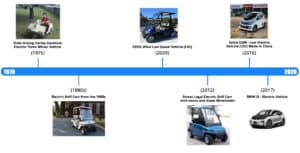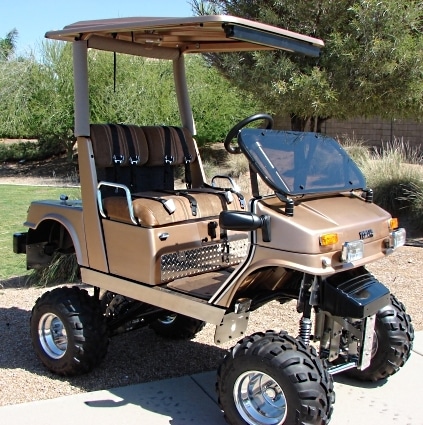For the past several decades, we have been living in a world dominated by gas guzzlers. From the American Ford to the Japanese Honda, consumers have been buying cars to commute to work and travel various continents. However, the standard gas vehicle has been disrupted by the rise and need for cleaner efficiency that has come in the form of electric vehicles. Now, most people associate electric vehicles with the luxurious, yet sexy Tesla. However, we sometimes forget the impact of a small electric vehicle, such as the golf cart, has impacted an evolutionary shift from gas guzzlers to electric efficiency.
Golf Carts Spawn Into Other Uses
The year was 1932 when the first custom made golf cart hit a golf course in Texarkana, Texas/Arkansas. The basic idea spawned from an electric three wheeled unit that had been designed to transport elderly citizens back and forth to the grocery store. It wasn’t until the mid 1950s when golf carts started to become widely accepted by the golfing community.
From that point, we began to see the molding of a multitude of golf cart manufacturers. The start of the well known golf cart brands, E-Z-GO and Club Car, both began in the 1950s. Also, Harley Davidson was a major player in the golf cart market segment until the 1980s when it sold to another entity.
Golf Carts In Retirement Communities
Through the 1990s, it was very common to see a fleet of 20 to 40 golf carts on every golf course in the US. This eventually led to being a popular mode of transportation for residents of private golf communities and in turn, retirement communities. The rise of retirement communities all over the US was fueled by the baby boomer generation.
For instance, the Villages in Florida is a 55+ residential community with golf courses, shopping malls, activity centers and anything you could want from a nicely developed, residential retirement community. In locations like these, it is not uncommon for households to own one car and two golf carts. This led to a crucial step for the evolution of golf
carts into a stable transportation vehicle since they became equipped more like cars in terms of safety features and offered a wide variety of accessories to choose from.
The Introduction of the Low-Speed Vehicle
Since many individuals around the US were starting to use the golf cart on the street like the Villages mentioned above, the National Highway Traffic Safety Administration decided to introduce a Federally regulated segment known as a Low-Speed Vehicle. The Low-Speed Vehicle (LSV) looks like a golf cart, however it has a number of key differences.

An LSV has to carry a 17 digit vin number like a car and is also licensed. On top of that, it has several key safety elements such as seat belts, headlights, brake lights and other safety oriented standards.
LSVs were primarily released as electric vehicles and were even applicable for some EV tax incentives through the years on some federal and state levels. The reason for the difference in federal and state level incentives was due to differing states having certain laws that applied to golf carts and LSVs.
Another motivating factor for releasing the LSV segment was for a building platform for a potential modern day electric vehicle.
With the LSV becoming more desired for its faster speed and safer attributes, the continued growth of this vehicle segment is primarily driven by the Baby Boomer generation. We are in the midst of one of the largest generations retiring. Since 2010, there are 10,000 baby boomers retiring every day, and a large portion of retirees are living in communities specifically designed for LSVs. Many of the manufacturers were aware of this trend and have poised themselves to capture a significant portion of this market share.
Global Impact of Small Electric Vehicles
So, we have an emerging small electric vehicle in the form of a golf cart being used as a transportation unit for retirees. Why do we care? Well, if we hop over the Pacific Ocean, we find the emersion on a grand scale for small electric vehicles in China.

In China, rather than referencing a small electric vehicle as an LSV, they reference this class of unit as a Low Electric Vehicle or LEV. This sector of the market is booming right now in China. Right now, China has the most electric vehicles sales to date as compared to any other country. The amazing stat though is that in 2014, the LEV accounted for over 300,000 unit sales as stated by the State Media.
That is more than Tesla has sold in the entirety of their existence. All of the LEVs being sold in China use strikingly similar components as the LSVs and Golf Carts seen in the US. It creates a blend of Golf Cart Parts and Automobile Features that joins two industries directly together. Even BMW has seen the appeal of electric vehicles and has decided to make a bet on the success for electric vehicles by developing the BMW i3 which holds a position in the top 3 worldwide selling all electric vehicle.
Potential Future for Small Vehicle Commuters
Now that we have seen the evolution in its entirety, where do we go from here? Golf is not growing in popularity, so the decline of golf cart sales to courses will start to wind down, so it becomes important to focus on markets that will need local urban transportation. Research has dictated that the average consumer commutes less than 7 miles.
A small electric vehicle can easily traverse this far. More and more communities are designed with the intent to allow the consumer to get what they need locally. Therefore, the case could be made that households may only need one automobile and possibly a small electric vehicle. This would reduce expenses for the household as a whole.
In the US however, this trend may never fully take shape except for in specific retiree communities. In contrast though, what if you don’t even need a car? With Uber’s ease of use and the future expectation of autonomous vehicles, the need to own a full fledged car may not be necessary. To go see the neighbors and travel to the gym, a household may only need a small electric vehicle. All in all, the markets will determine the future evolution of Golf Carts into Small Electric Vehicles.
Author: Caleb Amundson
Bio: Caleb Amundson is a professional in the Golf Cart Industry and has held positions such as a Service Tech, Sales Manager, and General Manager. He has also worked for an OEM as a Regional Sales Manager selling small sized electric vehicles also known as LSVs.














Leave a Reply